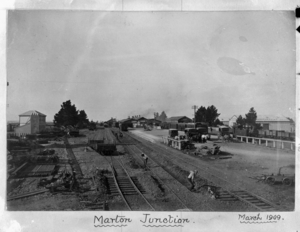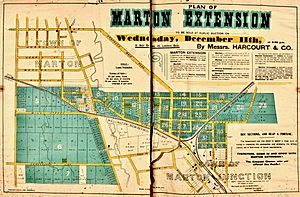Marton, New Zealand facts for kids
Quick facts for kids
Marton
|
|
|---|---|
|
Town
|
|

Marton Junction railway yard and station 1909
|
|
| Country | New Zealand |
| Region | Manawatū-Whanganui |
| District | Rangitikei District |
| Wards |
|
| Named for | Marton, England |
| Electorates |
|
| Area | |
| • Total | 10.99 km2 (4.24 sq mi) |
| Elevation | 152 m (499 ft) |
| Population
(June 2023)
|
|
| • Total | 5,590 |
| • Density | 508.6/km2 (1,317.4/sq mi) |
| Postcode(s) |
4710
|
| Area code(s) | 06 |
Marton (which is also called Māori: Tutaenui in Māori) is a town in the Rangitikei District of New Zealand. It's part of the Manawatū-Whanganui region on the North Island. Marton is about 35 kilometres southeast of Whanganui and 40 kilometres northwest of Palmerston North.
The Ngāti Apa people are the original inhabitants, or tangata whenua, of the Marton area.
Marton is the biggest town in the Rangitikei district. It started as a private town in 1866. Local landowners sold plots of land for shops and houses.
As of June 2023. , Marton had 5,590 people living there.
Marton has always been a key service town for the rich farming areas nearby. Farmers produced things like butter, wool, and flour. When the railway arrived in 1878, the town grew quickly. New businesses like engineering, sawmills, and textile factories started up.
Contents
Marton's Story: A Look at its History
For three years, the small village was known as Tutaenui. This name came from the stream that runs through the town. In 1869, local people decided to change the name to Marton. They wanted to honour Captain James Cook's birthplace in Marton, England. This change happened exactly 100 years after Cook landed in New Zealand.
From the very beginning, Marton was a great place for farmers to get supplies. Farmers started arriving in the early 1850s. They first grew butter and wool, then began growing wheat in 1863. Big wheat harvests led to three flourmills opening in the area by 1864.
After the town officially opened in 1866, many businesses appeared. There were general stores, two hotels, and several blacksmiths. Marton became a hub for the horse industry. Saddlers, wheel makers, and coach builders all competed for customers. Special horses like Clydesdales helped new farms get started.
The railway line connecting Wanganui to Palmerston North opened in 1878. This line is now part of the North Island Main Trunk railway. Marton became a busy railway junction, a position it held for 100 years. The railway station moved in 1898. This led to a large new area called 'Marton Extension' being built from 1907.
Timber from the Rangitikei forests supplied the town's two timbermills, which started in 1889.
Industries in Marton grew steadily. They started with flourmilling, brickmaking, and wool presses. By the late 1950s, Marton had many different factories. They made a wide range of products. These included men's shirts, safety cabs for tractors, soft drinks, and even dog biscuits.
About 9 kilometres from Marton was the large Lake Alice Hospital. This hospital cared for people with mental health conditions. It opened in 1950 and closed in 1999. It had a special high-security unit and helped hundreds of patients during its 49 years.
Marton's Newspapers
Marton's first newspaper was called the Rangitikei Advocate and Manawatu Argus. It started in 1875. Another newspaper, the Mercury, was published from 1891 to 1896. The Rangitikei Advocate closed in 1941. Later, the weekly Rangitikei News ran from 1948 to 1955. Today, the Feilding-Rangitīkei Herald serves the area.
Marton's Environment: Understanding its Geography
Marton's Climate
Marton has a mild climate. It doesn't have extreme weather like some other parts of New Zealand. Summers are warm, with average temperatures in the low 20s Celsius. The best weather is usually in summer and early autumn. Winters are not too cold, and there is a moderate amount of rain each year. Marton gets over 2,000 hours of sunshine annually.
| Climate data for Marton | |||||||||||||
|---|---|---|---|---|---|---|---|---|---|---|---|---|---|
| Month | Jan | Feb | Mar | Apr | May | Jun | Jul | Aug | Sep | Oct | Nov | Dec | Year |
| Mean daily maximum °C (°F) | 22.1 (71.8) |
22.5 (72.5) |
20.7 (69.3) |
18.1 (64.6) |
15.1 (59.2) |
12.8 (55.0) |
12.1 (53.8) |
12.9 (55.2) |
14.5 (58.1) |
16.4 (61.5) |
18.3 (64.9) |
20.3 (68.5) |
17.2 (63.0) |
| Daily mean °C (°F) | 17.4 (63.3) |
17.7 (63.9) |
16.1 (61.0) |
13.7 (56.7) |
11.0 (51.8) |
8.9 (48.0) |
8.2 (46.8) |
8.9 (48.0) |
10.5 (50.9) |
12.3 (54.1) |
14.0 (57.2) |
15.9 (60.6) |
12.9 (55.2) |
| Mean daily minimum °C (°F) | 12.8 (55.0) |
12.9 (55.2) |
11.6 (52.9) |
9.3 (48.7) |
7.0 (44.6) |
5.1 (41.2) |
4.3 (39.7) |
4.9 (40.8) |
6.6 (43.9) |
8.2 (46.8) |
9.8 (49.6) |
11.6 (52.9) |
8.7 (47.7) |
| Average rainfall mm (inches) | 79.7 (3.14) |
65.2 (2.57) |
80.4 (3.17) |
73.0 (2.87) |
92.3 (3.63) |
98.9 (3.89) |
97.2 (3.83) |
85.1 (3.35) |
80.9 (3.19) |
93.2 (3.67) |
79.0 (3.11) |
92.0 (3.62) |
1,016.9 (40.04) |
| Source 1: Climate-charts.com | |||||||||||||
| Source 2: Climate-data.org | |||||||||||||
Who Lives in Marton: Demographics
Marton covers about 10.99 square kilometres. As of June 2023, it had an estimated population of 5,590 people. This means there are about 509 people per square kilometre.
| Historical population | ||
|---|---|---|
| Year | Pop. | ±% p.a. |
| 2006 | 4,932 | — |
| 2013 | 4,794 | −0.40% |
| 2018 | 5,268 | +1.90% |
In the 2018 New Zealand census, Marton had 5,268 residents. This was an increase of 474 people since the 2013 census. There were 2,037 homes in the town.
The people living in Marton come from different backgrounds. About 75.9% were European/Pākehā, and 23.7% were Māori. There were also people from Pacific Islands, Asia, and other places. About 16.1% of Marton's residents were born outside New Zealand.
When asked about religion, 42.5% of people said they had no religion. About 42.2% were Christian. Some people also followed Māori religious beliefs or other religions.
Fun and Games: Culture and Sports
Sports Clubs in Marton
Marton has four main sports clubs for young people and adults to join:
- Marton Cricket Club
- Marton Rugby and Sports Club
- Marton Bears Rugby League Club
- Marton United AFC (football/soccer)
Getting Around: Transport in Marton
State Highway 1 passes about 4 kilometres east of Marton. State Highway 3 is about 7 kilometres to the south.
The closest airports are Whanganui Airport, which is 37 kilometres west, and Palmerston North Airport, 44 kilometres southeast. Both of these airports are for flights within New Zealand only.
Marton is on the North Island Main Trunk Line, which is a main railway line. Another line, the Marton-New Plymouth Line, also starts here. In the past, passenger trains like the Overlander used to stop at Marton railway station. However, the newer Northern Explorer train, which started in 2012, has fewer stops and does not stop in Marton.
Learning in Marton: Education
Marton has several schools for students of different ages.
There are four co-educational state primary schools for students in Year 1 to 8:
- Marton School, with 194 students.
- Marton Junction School, with 91 students.
- James Cook School, with 153 students.
- South Makirikiri School, with 108 students.
Marton also has two other primary schools:
- St Matthew's School is a state-integrated Catholic primary school, with 57 students.
- Huntley School is a private Anglican boarding school, with 167 students.
For older students, there are two secondary schools:
- Rangitikei College is a co-educational state secondary school, with 321 students.
- Nga Tawa Diocesan School is a state-integrated boarding school for girls in Year 9 to 13, with 196 students.
Until 2016, there was also a third secondary school called Turakina Māori Girls' College.
Famous Faces: Notable People from Marton
- Francis Arkwright, a politician.
- Bruce Beetham, a politician from the Social Credit party.
- Iris Crooke, a nurse who received the Florence Nightingale Medal.
- Israel Dagg, a famous All Black rugby player.
- Sir Michael Fowler, an architect and former Mayor of Wellington.
- James Laurenson, an actor.
- Kaleb Ngatoa, a motor racing driver.
- Launcelot Eric Richdale, a scientist who studied birds.
- Norman Shelton, a National Party Member of Parliament.



